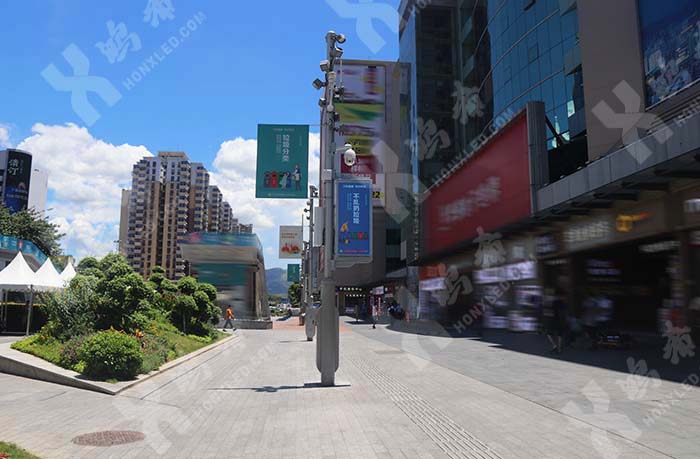Outdoor LED display screens are a popular choice for advertising, entertainment, and public information due to their brightness, visibility, and durability. But have you ever wondered why outdoor screens typically feature larger pixel spacing (or pixel pitch) compared to indoor displays? This article explores the main reasons—ranging from environmental challenges to technical realities and market-driven considerations.

Outdoor environments present unique challenges that directly influence the design of LED screens, including pixel spacing.
a) Intense Sunlight
Sunlight can cause unwanted visual effects like the moiré pattern, especially on tightly packed pixels. Larger pixel spacing reduces this risk, ensuring clearer images under bright sunlight and making content easier to see in outdoor daylight conditions.
b) Designed for Long-Range Viewing
Outdoor screens are meant to be viewed from far away—on streets, at stadiums, or in public plazas. High pixel density is unnecessary in these scenarios. A wider pixel pitch provides adequate clarity while keeping the screen visually effective for distant viewers.
c) Weather-Resistant Structure
Rain, wind, dust, and UV rays can all take a toll on electronic equipment. Outdoor LED displays with larger gaps between pixels allow for better ventilation and water resistance. This makes them more durable in fluctuating and often harsh weather conditions.

Beyond the weather and viewing environment, technical constraints also shape the design of outdoor LED screens.
a) LED Chip Size and Cost
LED chips used for outdoor screens are relatively large. Reducing the pixel pitch would require smaller, more expensive chips, significantly raising production costs. At current technology levels, it’s not always feasible or cost-effective to produce outdoor screens with small pixel spacing.
b) Controller and Driver Limitations
Each pixel requires a driver IC. As the pixel pitch decreases, the number of required ICs increases dramatically. This adds complexity and cost, both in terms of hardware and in power management.
c) Manufacturing Complexity
Producing high-resolution outdoor displays demands extremely precise manufacturing and high-grade materials. Smaller pixel pitch increases the difficulty of achieving consistent quality and ruggedness. Larger spacing helps manufacturers maintain performance standards while controlling costs.

Outdoor screens serve different purposes than indoor high-definition displays. Most are designed to deliver strong visual impact in large, open areas.
a) Large-Scale Advertising
Digital billboards and roadside LED signs aim to grab attention from a distance. High pixel density isn't needed for this application. A larger pitch ensures bright, bold visuals that remain legible from far away.
b) Live Events and Performances
At concerts or outdoor festivals, screens often act as dynamic backgrounds or support visuals. A wider pixel pitch still achieves the desired effect without inflating the budget.
c) Sports Facilities
In arenas and stadiums, screens serve thousands of spectators. A large pitch enables clear visibility for scores, replays, and announcements without sacrificing brightness or legibility.

Choosing a larger pixel pitch for outdoor LED displays comes with several practical benefits:
Improved Heat Dissipation: Wider gaps between LEDs enhance airflow, reducing the risk of overheating.
Stronger Weatherproofing: Extra space allows better waterproof designs and structural reinforcements.
Lower Production Costs: High-definition resolution isn't needed from afar, reducing overall manufacturing and maintenance expenses.
Striking Visual Presence: Ensures images and videos remain bold and clear even in expansive, high-traffic areas.
As technology evolves, smaller-pitch LED displays will likely become more accessible and rugged enough for outdoor use. Advancements in mini-LEDs, micro-LEDs, and improved IC technology may allow higher resolution outdoor displays at lower costs. However, until those solutions become mainstream, larger spacing remains the smart and reliable choice for outdoor deployments.

The use of larger pixel spacing in outdoor LED displays isn’t a flaw—it’s a functional and strategic decision. It reflects a careful balance between environmental resilience, technical feasibility, and market expectations. As innovation continues, the outdoor LED display landscape will evolve, but for now, large pixel pitch remains a trusted standard for delivering high-impact visuals in the open air.

